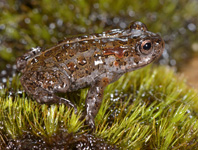Abstract
Neopanorpa chillcotti Byers, 1971 was originally described from Kathmandu in Nepal and is now found to be distributed in Gyirong, Tibet in China. The species is redescribed and illustrated based on new material from China and Nepal. The generic status of this species is briefly discussed.
References
Archibald, S.B. (2010) Revision of the scorpionfly family Holcorpidae (Mecoptera), with description of a new species from Early Eocene McAbee, British Columbia, Canada. Annales de la Société entomologique de France, New Series, 46 (1–2), 173–182.
https://doi.org/10.1080/00379271.2010.10697654
Byers, G.W. (1971) A new Neopanorpa from Nepal. Journal of the Kansas Entomological Society, 44 (4), 534–539. Avaliable from: http://www.jstor.org/stable/25082457 (Accessed 15 Feb. 2017)
Byers, G.W. & Thornhill, R. (1983) Biology of the Mecoptera. Annual Review of Entomology, 28 (1), 203–228.
https://doi.org/10.1146/annurev.en.28.010183.001223
Cai, L.-J. & Hua, B.-Z. (2009) A new Neopanorpa (Mecoptera, Panorpidae) from China with notes on its biology. Deutsche Entomologische Zeitschrift, 56 (1), 93–99.
https://doi.org/10.1002/mmnd.200900008
Chau, H.C.S. & Byers, G.W. (1978) The Mecoptera of Indonesia: Genus Neopanorpa. The University of Kansas Science Bulletin, 51 (11), 341–405.
Cheng, F.Y. (1957) Revision of the Chinese Mecoptera. Bulletin of the Museum of Comparative Zoology, 116 (1), 1–118.
Engels, S. & Sauer, K.P. (2006) Love for sale and its fitness benefits: nuptial gifts in the scorpionfly Panorpa vulgaris represent paternal investment. Behaviour, 143 (7), 825–837.
https://doi.org/10.1163/156853906778017962Esben-Petersen, P. (1921) Mecoptera. Monographic Revision: Collections Zoologiques du Baron Edm. De Selys Longchamps. Catalogue Systematique et Descriptif, 5, 1–172.
Hu, G.-L., Yan, G., Xu, H., & Hua, B.-Z. (2015) Molecular phylogeny of Panorpidae (Insecta: Mecoptera) based on mitochondrial and nuclear genes. Molecular Phylogenetics and Evolution, 85, 22–31.
https://doi.org/10.1016/j.ympev.2015.01.009
Krzemiński, W. & Soszyńska-Maj, A. (2012) A new genus and species of scorpionfly (Mecoptera) from Baltic amber, with an unusually developed postnotal organ. Systematic Entomology, 37 (1), 223–228.
https://doi.org/10.1111/j.1365-3113.2011.00602.x
Lieftinck, M.A. (1936) Studies in Oriental Mecoptera I. The genus Leptopanorpa in Malaysia. Treubia, 15 (3), 271–320.
Ma, N., Zhong, W., Gao, Q.-H. & Hua, B.-Z. (2012) Female genital plate diversity and phylogenetic analyses of East Asian Panorpidae (Mecoptera). Systematics and Biodiversity, 10 (2), 159–178.
https://doi.org/10.1080/14772000.2012.683459
McLachlan, R. (1875) A sketch of our present knowledge of the neuropterous fauna of Japan (excluding Odonata and Trichoptera). Transactions of the Royal Entomological Society of London, 23 (2), 167–190.
https://doi.org/ 10.1111/j.1365-2311.1875.tb01906.x
Mickoleit, G. (1971) Zur phylogenetischen und funktionellen Bedeutung der sogenannten Notalorgane der Mecoptera (Insecta, Mecoptera). Zeitschrift für Morphologie der Tiere, 69 (1), 1–8.
https://doi.org/10.1007/bf00294385
Miyaké, T. (1913) Studies on the Mecoptera of Japan. Journal of the College of Agriculture, Imperial University of Tokyo, 4, 265–400.
Palmer, C.M. (2010) Diversity of feeding strategies in adult Mecoptera. Terrestrial Arthropod Reviews, 3 (2), 111–128.
https://doi.org/10.1163/187498310x519716
Rust, M.K. & Byers, G.W. (1976) The Mecoptera of India and adjacent regions. The University of Kansas Science Bulletin, 51 (2), 19–90.
Thornhill, R. & Sauer, K.P. (1991) The notal organ of the scorpionfly (Panorpa vulgaris): an adaptation to coerce mating duration. Behavioral Ecology, 2 (2), 156–164.
https://doi.org/10.1093/beheco/2.2.156
van der Weele, H.W. (1909) Mecoptera and Planipennia of Insulinde. Notes from the Leyden Museum, 31, 1–100.
Willmann, R. (1989) Evolution und Phylogenetisches System der Mecoptera (Insecta: Holometabola). Abhandlungen der Senckenbergischen Naturforschenden Gesellschaft, 544, 1–153.
Willmann, R. & Novokschonov, V. (1998) Neue Mecopteren aus dem oberen Jura von Karatau (Kasachstan)(Insecta, Mecoptera:‘Orthophlebiidae’). Paläontologische Zeitschrift, 72 (3–4), 281–298.
https://doi.org/10.1007/bf02988359
Zhong, W. & Hua, B.-Z. (2013) Mating behaviour and copulatory mechanism in the scorpionfly Neopanorpa longiprocessa (Mecoptera: Panorpidae). PLoS ONE, 8 (9), e74781.
https://doi.org/10.1371/journal.pone.0074781
Zhong, W., Ding, G. & Hua, B.-Z. (2015) The role of male’s anal horns in copulation of a scorpionfly. Journal of Zoology, 295 (3), 170–177.
https://doi.org/10.1111/jzo.12194

